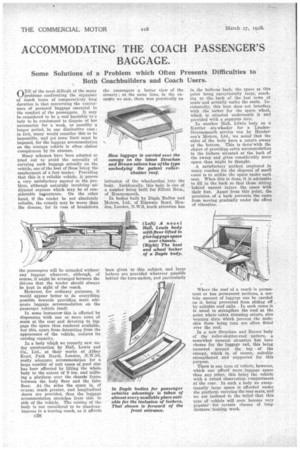ACCOMMODATING THE COACH PASSENGER'S
Page 132

If you've noticed an error in this article please click here to report it so we can fix it.
BAGGAGE.
Some Solutions of a Problem which Often Presents Difficulties to Both Coachbuilders and Coach• Users.
ONE of the most difficult of the many problems confronting the organizer of coach tours of comparatively long duration is that concerning the conveyance of personal baggage essential to the comfort of the passengers. It may be considered to be a real hardship to a lady to be condemned to dispose of her necessaries for a week, or possibly a longer period, in one diminutive case ; in fact, many would consider this to be impossible, and yet Some limit must be imposed, for the luggage accommodation on the average vehicle is often alniost conspicuous by its absence.
Many schemes have been adopted or tried out to avoid the necessity of carrying such baggage actually on the vehicle, one of the best of these being the employment of a fast tender. Providing that this is a reliable vehicle, it proves a very satisfactory answer to the problem, although naturally involving additional expense which may be of considerable importance. On the other hand, if the tender be not absolutely reliable, the remedy may be worse than the disease, for in case of breakdown
the passengers will be stranded without any luggage whatever, although, of course, it might be arranged between the drivers that the tender should always be kept in sight of the coach.
However, for ordinary purposes, it would appear better to do everything possible towards providing more adequate luggage accommodation on the passenger vehicle itself.
In some instancesthis is effected by dispensing with one or more rows of seats at the rear and devoting to luggage the space thus rendered available. but this, apart from detracting from the appearance of the vehicle, reduces its earning capacity.
In a body which we recently saw under construction by Hall, Lewis and Co:, Ltd., at their works at Abbey Road, Park Royal, London, N.W.10, really adequate accommodation for a large number of suit eases of good size has been afforded by lifting the whole body to the extent of 9 ins, and utilizing a platform over the chassis frame hatween the body floor and the false floor. At the sides the space is, of course, much greater, and longitudinal doors are provided, thus the luggage accommodation stretches from side to side of the vehicle. The raising of the body is not considered to be disadvantageous in a touring coach, as it affords
c38 the passengers a better view of the scenery; at the same time, in the examikle we saw, there was practically no intrusion of the wheelarches into the body. Incidentally. this body is one of a number being built for Elliott Bros., of Bournemouth.
In bodies built by Duple Bodies and Motors, Ltd., of Edgware Road, Hendon, London, N.W.9, much attention has been given to this subject, and large lockers are provided wherever possible behind the turn-unclers, and particularly in the bulbous back, the space at this point being exceptionally large, reaching to the back of the last rows of seats and actually under the seats. Incidentally, this boot does not interfere with the locker for the spare wheel, which is situated underneath it and Provided with a separate door.
In another Hall,. Lewis body on a Karrier six-wheeler for a LondonBournemouth service run by Henderson's Motors, Ltd., we noted that the sides of the body have a return sweep at the bottom. This is done/with the object of providing extra accommodation in the lockers situated at the back of the sweep and gives considerably more space than might be thought.
A satisfactory method employed in many coaches for the disposal of small cases is to utilize the space under each seat. When this is done, it is advisable to fill in the back so that those sitting behind cannot injure the cases with their feet. Apart from this point, the provision .of a back prevents the cases from moving gradually under the effect of vibration.
Where the roof of a coach is permanent or has permanent sections, a certain amount of luggage can be carried on it, being prevented from sliding off , by suitable roof rails. In such cases it is usual to strengthen the roof at the point where extra stressing occurs, also wearing slats which prevent the moleskin from being torn are often fitted over the roof.
In a new Strachan and Brown body of the roller-shutter-roof pattern, a somewhat unusual situation has been chosen for the luggage rail, this being mounted around the top of the canopy, which is, of course, suitably strengthened and supported for this purpose.
There is one type of vehicle, however, which can afford more luggage space than any other, this being the vehicle with a raised observation compartment at the tear. In such a body an exceptionally large space is afforded under, the platform carrying the rear seats, and we are inclined to the belief that this type of vehicle will soon become very popular for certain classes of longdistance touring work.




























































































































































































